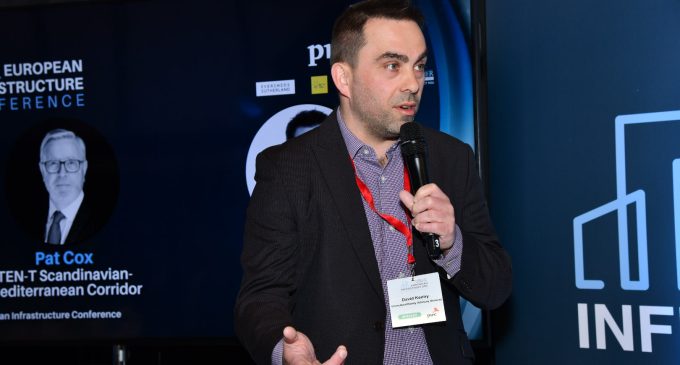Telecoms concession provides a path for Ireland’s energy transition

The development of the Corrib gas field in Connacht has provided a path to meet Ireland’s greatest infrastructure challenges including replacing gas, writes David Keniry.
Ireland’s Minister for the Environment, Climate and Communications Eamon Ryan is inviting tenders for strategic, economic, commercial, and technical advisory services to support the Digital Connectivity Office (DCO) of the Department of the Environment, Climate and Communications (DECC). The services required will be tendered as four individual lots including technical, commercial, and financial advisory services for the Galway-Mayo ducting project.
The scope of services for the Galway-Mayo ducting project includes specialist technical advice on wholesale duct, dark fibre and managed capacity business in addition to network management and maintenance requirements, health and safety matters, interconnection requirements, marketing proposals to stimulate the use of infrastructure.
The Galway Mayo ducting project refers to management of a backhaul telecommunications duct that was constructed alongside a gas pipeline between south Galway (Ballymoneen) and north Mayo (Bellanaboy), with a further spur to the outskirts of Castlebar and Westport, to allow for the provision of open access telecommunications services in this area.
This project is aiming to appoint a Managed Services Entity (MSE) to manage, maintain and operate this infrastructure under a concession agreement or a managed services agreement as appropriate, in a similar manner to the MSE that manages the Metropolitan Area Networks and in line with the State Aid decision that underpins it.
The Galway-Mayo Network is regarded by DECC as a piece of critical infrastructure in an area of strategic importance particularly in relation to providing support for future transatlantic fibre cable systems landing on the west coast of Ireland for which terrestrial backhaul is a requirement. As a result, the Galway-Mayo Network is expected to have a key role to play in supporting delivery of some of the targets as detailed in the Government’s Digital Connectivity Strategy for Ireland 2022 (DCS). The Department will undertake a procurement process for the appointment of a MSE to manage this infrastructure.
The MSE will be required to operate, market, and maintain the network on behalf of the State on an open access, carrier neutral and self-funding basis and in line with the requirements of the State Aid decision underpinning it. A call for market input on the procurement of an economic operator to operate and manage the Galway-Mayo Network was issued in December 2023.
The purpose of this call for market input is to inform economic operators of the Department’s procurement plans relating to this piece of telecommunications duct infrastructure and to invite economic operators to provide information and contribute their views on the potential use of the network. The completion of this process will inform the development of the procurement process that will be used to appoint an MSE.
Technical, commercial, and financial advice will be required on all aspects of the development and delivery of the procurement process through to contract award and the management and governance of a concession agreement to maximise the utilisation of the infrastructure and minimise the level of public funds required. Support will also be required to assist with any legacy issues and the transition to the permanent concession arrangements.
The market engagement exercise in relation to the Galway Mayo Telecommunications Network is primarily aimed at economic operators that are telecommunications service providers and other entities or organisations that may have the expertise to manage, market and maintain an operational telecommunications network. Analysis of the responses will assist DECC in determining the most appropriate procurement option to pursue.
In 2005 during the planning of the Mayo-Galway gas pipeline by Bord Gáis Éireann (now Ervia), the then Department of Communications, Marine and Natural Resources (now DECC) agreed to fund the installation of telecommunications ducting alongside the new gas pipeline. The construction of the gas pipeline provided a unique opportunity to install, at a marginal cost, telecommunications ducting along a route that did not have any existing telecommunications duct capacity at the time. It also provided an opportunity to lay telecommunications ducting along a route that is very secure from accidental damage due to the high level of monitoring by BGÉ in order to protect the gas infrastructure.
The gas pipeline and 132 km of telecommunications ducting were installed by Shell E&P Ireland Limited (SEPIL) between BGÉ’s Above Ground Installation at Ballymoneen in County Galway and SEPIL’s new gas terminal constructed in Bellanaboy County Mayo.
In addition to the telecommunications ducting installed alongside the gas pipeline, the Department also funded the installation of telecommunications ducting along a 22.3 km spur from the main pipeline ducting interconnecting Castlebar and Westport. The Castlebar and Westport spur is deployed along public roadway, primarily the N5 national primary road.
The Westport spur is not currently operational, and no fibre has been installed in the ducting.
Although the construction of the main trunk and the Westport spur took place between 2006 and 2008 it was not until the completion of some key developments that the main trunk of the network was first brought into operation.
The installation of the telecommunications ducting and the proposal to bring the Galway-Mayo Network fully into operation through the appointment of an MSE, is the subject of a State Aid approval decision by the European Commission in 2013. The State Aid Decision includes restrictions associated with the use of the Galway-Mayo Network in relation to the provision of backhaul infrastructure and services, as well as restrictions from an access network provision perspective. The restrictions must be considered as part of any future procurement process.
The State Aid Decision refers to a further section of 24kms of ducting, sub ducting and fibre from Bellanaboy to the coastal area of Belmullet in County Mayo. This 24km route has not been constructed. At present there are no plans for the completion of this extension but views on the potential for this would be welcomed.
In accordance with the DCS, digital connectivity will be delivered across the State primarily thorough the commercial investment of the telecommunications industry, supported by the roll out of the National Broadband Plan. However, the Government will take measures to drive increased Gigabit and 5G connectivity, including complementing commercial investment in infrastructure with Government-led initiatives and through facilitating other strategic enablers.
In 2015 as part of the Corrib Gas Field development, SEPIL installed fibre optic cable at no cost to the State with ownership vesting in the State.
A process to procure a Management Services Entity (MSE) to manage the infrastructure also commenced in 2015, with the completion of a pre-qualification process followed by briefing sessions with the pre-qualified candidates. However, this procurement process was suspended after the completion of the briefing sessions and subsequently cancelled pending resolution of outstanding issues in relation to access rights along the route of the telecommunications network.
In 2016 a significant section of the main trunk of the network was identified as a potential solution for the provision of a resilient terrestrial backhaul route for the Aqua Comms owned and operated subsea cable system interconnecting North America and the West of Ireland (AEC-1). The cable landing station for this cable system is located in Killala, County Mayo.
To support the requirement for a resilient terrestrial backhaul route the Department entered into an interim agreement with Gas Networks Ireland (GNI) to act as a temporary MSE for the provision of dark fibre services along a section. The Telecommunications Services (Ducting and Cables) Act 2018 was enacted in April 2018 to provide for the vesting in the Minister of the ownership of the ducting and cables.
The position in relation to the Westport spur will be confirmed as part of the commencement stage of the procurement process. If the Westport spur is to be included in any procurement process, the Department will ensure that all necessary access rights are in place before the public procurement procedure to appoint a permanent MSE is commenced.
The timeline would see a pre-qualification questionnaire launched in Q2 2024 and a preferred bidder in Q2 2025. Responses to the request for market information and the advisory tender are both due by 16 February 2024.
In hindsight the decision in 2005 (two years before the iPhone was launched) to use the Corrib Gas Field development to deliver critical digital infrastructure in Connacht speaks to the benefits of long-term planning and seizing an economic opportunity to deliver infrastructure that will be required, which is likely to be operating after the Corrib Gas Field is decommissioned.
In its latest outlook on the adequacy of the gas network GNI reported that the Corrib gas field is anticipated to meet 18% of Republic of Ireland demand, and 13% of GNI system demand over the entire winter 2023/24, having reached a production plateau in early 2018. Gas supplies from Great Britain via the Moffat Entry Point are expected to account for the balance of gas supply requirements for winter 2023/24; 82% of ROI demand and 87% of the GNI system demand will be met by Moffat.
A steady decline in production has been observed at Corrib since January 2018, in line with supply profile projections as provided by the operators of the Corrib gas field. Corrib operated at a level of 36% of historic maximum production capacity when averaged over winter 2022/23.
GNI added that given the decline in indigenous gas supply from Corrib, imports from Britain through the Moffat Entry Point continue to be the dominant supply source and provide the balance of gas supply after Corrib and biomethane.
With Ireland expected to be reliant on UK interconnection for over 90% of gas supply in
less than ten years, the Commission for Regulation of Utilities (CRU)’s Gas Security of Supply Annual Report 2023 describes the position of Ireland in the context of EU Regulation 2017/19382 on safeguarding the security of gas supply, and highlights non-compliance with the EU gas infrastructure standard as required by that Regulation.
This CRU report published in November stated that failure to comply with this EU standard puts Ireland at an increased risk of a gas security of supply event and with supply from the Corrib Gas Field expected to decline and overall gas demand expected to increase, Ireland’s inability to meet this requirement could continue and become more challenging in future years. This could be offset in part by increased renewable gas production.
In December, the CRU approved GNI’s investment plans up to 2027 with €2.21 billion in allowed revenues to support the development and decarbonisation of national gas infrastructure stating that ‘For Ireland to meet its carbon emissions targets for the energy sector, as set out in the Government Climate Action Plan 2023, it will be necessary for both the gas and electricity system to decarbonise in a secure and sustainable way.’
This week CRU opened a consultation that will consider the arrangements that may be required to facilitate greater decarbonisation of large energy demand and the potential increased requirement for renewable sources of generation. The consultation on the review of Large Energy Users connection policy is being conducted in response to recent developments including the Government publication of the Sectoral Emissions Ceilings and the Government Statement on the Role of Data Centres in Ireland’s Enterprise Strategy.
The Government of Ireland’s Energy Security Strategy is an electricity-led system with high renewable penetration, backed up by flexible gas-fired generation.
Going to press, the Eirgrid Smart Grid Dashboard shows a current average fuel mix for ROI of 9% coal ,13% renewables, 59% gas, and 13% net import, demonstrating vividly that the need for acceleration to build more electricity transmission, interconnection, and renewable energy generation cannot be overstated.
The delivery of the Galway Mayo Telecommunications Network in conjunction with the Corrib gas development demonstrated the value of right of way, and a dig-once approach to the delivery of infrastructure projects. It has also demonstrated how a joined-up approach can be mutually beneficial to infrastructure owners and operators.
The dividends from long-term approach to infrastructure and asset management, and the benefits of adopting public-private partnership models can also be demonstrated.
The demise of an indigenous gas supply is Ireland’s most urgent critical infrastructure challenge after healthcare. Although the healthcare crisis would be significantly exasperated in a supply event.
Ireland’s reliance on imported gas and energy security risk should increasingly influence a joined-up approach on decisions for infrastructure across sectors, including digital infrastructure. Like all major capital projects, the delivery of a renewable energy system that doesn’t cost the Earth requires digital infrastructure.
The importance of the Corrib gas field to energy security also demonstrates that an energy system that does not rely on fossil fuels depends on the development of, and connections to, Ireland’s offshore renewable energy resources.








